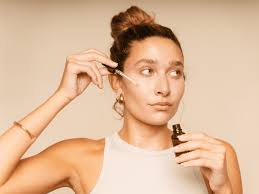
How To Apply Eye Creams and Serums: A Complete Step-by-Step Guide for Brighter, Healthier Eyes
The skin around your eyes is one of the most delicate and sensitive areas on your entire face, which is why applying eye creams or serums correctly is incredibly important.
Using the right technique helps you avoid irritation, maximize benefits, and get the most out of your eye product investment—whether you’re dealing with puffiness, dark circles, or fine lines.
As a dermatologist, I advise my patients to apply eye cream twice a day—once in the morning and once at night—after cleansing and before heavier products like moisturizer or sunscreen.
Eye skin is prone to dryness, fine lines, puffiness, discoloration, and environmental damage, so treating it gently and proactively can help preserve youthful firmness and smoothness.
In this blog post, you’ll learn the right steps to apply eye cream and serum, how to choose between them, and when each is best used in your daily skincare routine.
How Much Eye Cream or Serum Should You Use?
When it comes to eye cream, less is more—you only need about 1/8 of a teaspoon of product to treat both eyes effectively without overwhelming the thin skin or causing product buildup.
Use your ring finger to scoop up the product because it naturally applies less pressure than your index or middle finger, helping prevent unnecessary tugging or stretching of the skin.
Dot tiny amounts of the cream or serum in a semi-circle pattern along the orbital bone—this extends from the inner corner under your eye and up toward the outer edge under the brow.
Never slather product directly onto your lash lines or lids unless the instructions clearly indicate it is safe for the upper lid, as this can lead to eye irritation or product migration.
The Right Direction to Apply Eye Products
For the lower eyelid, always pat your eye cream from the outer corner inwards toward your nose—this helps support lymphatic drainage and reduces puffiness more efficiently.
On the upper eye area, gently glide or tap product from the inner corner outward, moving toward the temples to encourage circulation and prevent tugging that may lead to wrinkles.
Avoid rubbing or dragging the skin—light pressure with a tapping or pressing motion works best and ensures that the product sinks in without stretching this fragile area.
When to Apply Eye Cream in Your Routine
Timing matters when it comes to layering skincare products, especially around the eyes, where incorrect order may reduce absorption or trigger irritation from other actives.
Eye creams and serums should be applied immediately after cleansing and before your facial moisturizer or treatment serums to maximize penetration and protect the area.
Applying it too late in your routine—after heavier creams or occlusive layers—can prevent beneficial ingredients like peptides and humectants from properly reaching the skin.
Think of your eye product as a shield that not only delivers actives but also guards against harsher products like retinoids, exfoliants, or acne treatments used on the rest of your face.
3 Reasons to Apply Eye Cream Right After Cleansing
First, the ingredients in eye creams—like peptides, hyaluronic acid, and saccharides—can better penetrate clean skin and work effectively without any barriers.
Second, eye creams help fill in creases and fine lines, smoothing the surface and creating a more even canvas for makeup or sunscreen if you’re following with those.
Third, applying it early protects the area from more aggressive ingredients applied afterward, such as retinol, benzoyl peroxide, or glycolic acid, which may cause stinging or redness.
Should You Use Eye Cream in the Morning or Night?
For optimal results, eye products should be used both morning and night—but if you only have time once per day, prioritize your nighttime routine for deeper repair.
At night, your face may rub against pillowcases and transfer active treatments to your eyes, increasing the risk of irritation—eye cream creates a barrier to prevent that.
If you use retinoids or exfoliants in your PM routine, a barrier-repairing eye cream acts as a buffer, reducing side effects like flakiness or redness around the eye area.
Using eye cream in the morning also hydrates and smooths the under-eye skin, making it easier to apply concealer and reducing the appearance of puffiness and fatigue.
Eye Cream or Serum First?
You should not apply both an eye cream and an eye serum at the same time—they can dilute each other’s effectiveness and overload the thin skin with too many actives.
Instead, choose a lighter eye serum in the morning and a richer cream at night, or alternate them depending on your skincare concerns, like hydration vs. anti-aging.
If you’re dealing with crow’s feet or dark circles, use a brightening serum in the morning and a retinol-infused or collagen-boosting cream at night for optimal synergy.
When to Start Using Eye Products
There’s no universal age when you “must” begin using eye cream—it depends on your skin type and whether you’re experiencing issues like dryness, fine lines, or discoloration.
That said, it’s never too early to start preventive care, especially if you’re a wrinkle-prone skin type like the W Baumann type, which benefits from early intervention.
Signs that indicate it’s time to begin include puffiness, under-eye shadows, redness or irritation, tight or flaking lids, or sensitivity to makeup and cleansers.
If you’re not yet experiencing those symptoms, using your regular moisturizer around the eyes is generally fine—as long as it’s gentle and fragrance-free.
Choosing Morning vs. Night Eye Products
If you wear makeup during the day, an eye cream that doubles as a concealer primer can prevent creasing and help your under-eye look smoother and more even-toned.
Mixing a dab of your eye cream with your concealer creates a custom tinted hydrator that blends easily and avoids cakiness on dry or flaky skin.
At night, choose a more occlusive or protective eye product, especially if you’re using strong actives like retinoids or glycolic acid in your face routine.
If you suffer from eczema, dermatitis, or frequent redness around the eyes, use a soothing eye cream with anti-inflammatory agents morning and evening.
For puffiness, target nighttime use—eye swelling often occurs during sleep due to fluid buildup, and applying anti-puff products at night can help reduce that by morning.
Should You Use Eye Cream on the Upper Eyelids?
Many eye creams are not designed for use on the upper lid, where the skin is even thinner—opt for a lightweight serum if your goal is to hydrate or tighten the lid area.
Avoid eye serums that contain alcohol-based ingredients like ethanol, isopropyl alcohol, or sodium lauryl sulfate, which can sting, burn, or cause dryness.
Other common irritants to avoid on upper lids include ammonium lauryl sulfate, laureth-4, steareth-2, and certain fatty alcohols like ceteareth-20 or stearyl alcohol.
Check labels carefully to ensure the formula is safe for eyelid use—and when in doubt, apply only to the orbital bone and not directly onto the lid itself.
Can You Use Eye Cream on the Rest of Your Face?
While it might seem like a time-saver, don’t use your eye cream as a face cream—these formulas are richer and designed to stay on the surface, which can clog pores elsewhere.
Eye creams often include light-reflecting particles or film-forming ingredients to create a smoothing base for makeup—not ideal for oily or breakout-prone facial skin.
Using an eye cream all over may result in milia—tiny white bumps caused by trapped keratin—especially around the cheeks, nose, or forehead.
Stick to using face creams for your broader skincare concerns and reserve your eye cream for the targeted treatment of the under-eye and brow bone area.
Can You Use a Face Moisturizer Around the Eyes?
If you’re traveling or trying to simplify your skincare routine, a gentle face moisturizer without retinol, acids, or strong fragrances can substitute for an eye cream.
Choose a moisturizer that’s labeled “non-comedogenic” and free from harsh actives—Zerafite Wrinkle Defense Barrier Cream, for instance, is one option that layers well.
Some dermatologists use facial serums like Plated Intense under the eyes due to their anti-aging properties, though it’s best to confirm with the brand before applying near your eyes.
Avoid using anything near the eyes that hasn’t been tested for ophthalmic safety—this includes potent anti-aging serums unless verified by a professional.
Final Thoughts on Eye Creams and Serums
Using eye products correctly saves money, prevents side effects, and ensures that each formula delivers on its promises—especially given their high price points.
Always follow product-specific directions, consider your skin type, and avoid layering too many products under the eyes to prevent irritation or reduced effectiveness.
For best results, take a personalized skin type quiz to identify your skin concerns and match them with the most appropriate eye treatments tailored to your needs.
With the right application technique and routine, your eye cream or serum can become a powerful tool in your skincare arsenal—protecting and perfecting your most expressive features.


